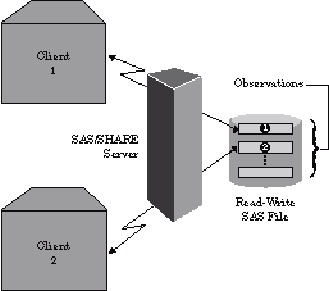Accessing SAS Files through a SAS/SHARE Server
The following figure
illustrates two client sessions that are accessing SAS files by using
a SAS/SHARE server.
The SAS/SHARE server enables multiple clients
to effectively share the same SAS file at the same time. In this context,
“share” means to allow access by multiple clients to
a different unit (for example, an observation) in the same SAS file.
In the preceding figure, Client 1 can read from and write to observation
1, and Client 2 can read from and write to observation 2 in the same
SAS file. Both clients can also read the same observation at the same
time. However, only one client at a time can write to an observation.
The
server enables client access to the lowest unit of the SAS library
hierarchy through its powerful lock manager facility. Locks are applied
in either of two ways:
The SAS/SHARE server evaluates each incoming client
request to access a specific SAS library unit (for example, a data
library, a data set, or an observation) against a complex set of locking
rules whose application seems transparent to clients. The server balances
the client requests for access to data while ensuring the integrity
of that data. The server grants permission to a qualifying client
and denies a conflicting request. The denied client receives an informational
message. For more information
about server locking rules, see Locking SAS Data Objects. For information about
the use of the LOCK command and the LOCK statement, see Locking Objects Explicitly (LOCK Statement), and Locking Explicitly in a SAS Window (LOCK Command).
